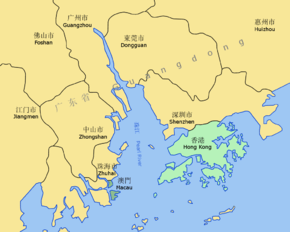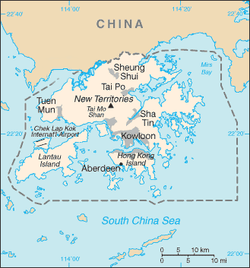Geography of Hong Kong
The geography of Hong Kong primarily consists of three main territories: Hong Kong Island, Kowloon Peninsula, and the New Territories.
The name "Hong Kong", literally meaning "fragrant harbour", is derived from the area around present-day Aberdeen on Hong Kong Island, where fragrant wood products and fragrant incense were once traded.[1] The narrow body of water separating Hong Kong Island and Kowloon Peninsula, Victoria Harbour, is one of the deepest natural maritime ports in the world. Hong Kong and its 260 territorial islands and peninsulas are located in the South China Sea, at the mouth of the Pearl River Delta.
The Kowloon Peninsula to the south of Boundary Street and the New Territories to the north of Hong Kong Island were added to Colonial Hong Kong in 1860 and 1898 respectively. The landscape of Hong Kong is fairly hilly to mountainous with steep slopes. The highest point in the territory is Tai Mo Shan, at a height of 958 metres.[2] Lowlands exist in the northwestern part of the New Territories.
Hong Kong is 60 km east of Macau on the opposite side of the Pearl River estuary. It has a land border with Shenzhen to the north. The remaining land is reserved as country parks and nature reserves .
Geographical information

Location

Hong Kong is located in eastern Asia, on the southeast coast of the People's Republic of China, facing the South China Sea.
Area
Total: 2,754 km2 (1,063 sq mi)
Land: 1,104 km2 (426 sq mi)
Sea: 1,650 km2 (640 sq mi)
Figures published by the Hong Kong Government Land Department[3]
Land boundaries
Total: 30 km
Border city: Shenzhen Special Economic Zone, Guangdong Province
Figures published by the United States Central Intelligence Agency[2]
Coastline
Total: 733 km
Maritime claims:
Territorial sea: 3 nm
Figures published by the United States Central Intelligence Agency[2]
Islands
Hong Kong has 263 islands over 500 m2,[4] including Hong Kong Island, Lantau Island, Cheung Chau, Lamma Island, Peng Chau and Tsing Yi Island.
Climate
Hong Kong's climate is subtropical and monsoonal with cool dry winters and hot and wet summers. As of 2006, its annual average rainfall is 2,214 mm (87.2 in), though about 80% of the rain falls between May and September. It is occasionally affected by tropical cyclones between May and November, most often from July to September. The mean temperature of Hong Kong ranges from 16 °C (60.8 °F) in January and February to 28 °C (82.4 °F) in July and August.[5]
January and February are more cloudy, with occasional cold fronts followed by dry northerly winds. It is not uncommon for temperatures to drop below 10 °C (50 °F) in urban areas. Sub-zero temperatures and frost occur at times on high ground and in the New Territories. March and April can be pleasant although there are occasional spells of high humidity. Fog and drizzle are common on high ground which is exposed to the southeast. May to August are hot and humid with occasional showers and thunderstorms. Afternoon temperatures often exceed 31 °C (87.8 °F) whereas at night, temperatures generally remain around 26 °C (78.8 °F) with high humidity. In November and December there are pleasant breezes, plenty of sunshine and comfortable temperatures.[6]
Terrain
Hong Kong's terrain is hilly and mountainous with steep slopes. There are lowlands in the northern part of Hong Kong. A significant amount of land in Hong Kong, especially on the Hong Kong Island and the Kowloon peninsula, is reclaimed.
Extreme points
The lowest elevation in Hong Kong is in South China Sea (0 m) while the highest elevation is at Tai Mo Shan (957 m) in Tsuen Wan, the New Territories.
Land
- Northernmost: Shenzhen River 22°33′44″N 114°9′41″E / 22.56222°N 114.16139°E
- Easternmost: Ping Chau 22°32′26″N 114°26′30″E / 22.54056°N 114.44167°E
- Southernmost: Tau Lo Chau 22°9′14″N 113°55′21″E / 22.15389°N 113.92250°E
- Westernmost: Peaked Hill 22°13′1″N 113°50′7″E / 22.21694°N 113.83528°E
Principal peaks of Hong Kong

- Tai Mo Shan - 957 m, Tsuen Wan
- Lantau Peak (Fung Wong Shan) - 934 m, on Lantau Island
- Sunset Peak (Tai Tung Shan) - 869 m, on Lantau Island
- Sze Fong Shan - 785 m
- Lin Fa Shan - 766 m, on Lantau Island
- Nei Lak Shan - 751 m, on Lantau Island
- Yi Tung Shan - 747 m, on Lantau Island
- Ma On Shan - 702 m
- The Hunch Backs (Ngau Ngak Shan) - 674 m
- Grassy Hill - 647 m
- Wong Leng - 639 m
- Buffalo Hill - 606 m
- West Buffalo Hill - 604 m
- Kowloon Peak (Fei Ngo Shan) - 602 m
- Shun Yeung Fung - 591 m
- Tiu Shau Ngam - 588 m
- Kai Kung Leng - 585 m
- Castle Peak - 583 m
- Lin Fa Shan, Tsuen Wan - 578 m
- Tate's Cairn (Tai Lo Shan) - 577 m
Victoria Peak, the highest point on Hong Kong Island, at 552 m is the 24th highest peak in Hong Kong.
Natural resources
The natural resources of Hong Kong can be divided into three main categories:
- Metalliferous minerals and non-metalliferous industrial minerals in the onshore area;
- Quarried rock and building stone;
- Offshore sand deposits.
Despite its small size, Hong Kong has a relatively large number of mineral occurrences. Some mineral deposits have been exploited commercially. Metalliferous mineral occurrences are grouped into four broad categories: tin-tungsten-molybdenum mineralisation, copper-lead-zinc mineralisation, iron mineralisation and placer deposits of tin and gold. Mesozoic igneous activity is largely responsible for this diversity of mineral deposits and the mineral concentrations have been variably enhanced by hydrothermal activity associated with faulting. Concentrations of non-metalliferous minerals that have been commercially exploited include kaolin clay, feldspar, quartz, beryl and graphite.[7]
For many years, granite and volcanic rocks have been quarried locally for road base metal, riprap, armour stone and asphalt, although the main purpose now is for concrete aggregates. At present, there are three quarries operating in Hong Kong. These are principally in granite and are located at Lam Tei, Shek O and Anderson Road. All the quarries are in the process of rehabilitation and have a life expectancy of between two and eight years.[7]
Offshore sand bodies have been dredged for aggregate sand and reclamation fill in Hong Kong as the rate of urban development has increased.[8]
Additional natural resources include forest and wildlife.
Land use
Arable land: 2.95%
Permanent crops: 0.95%
Other: 96.10% (2012 est.)
Figures published by the United States Central Intelligence Agency[2]
Big 22
Natural hazards
Tropical cyclones frequent Hong Kong during the summer months between June and August typically. Landslides are common after a rainstorm.
Environmental issues
- Air and water pollution from rapid urbanisation
- Extinction of natural species
- Introduction of exotic species
See also
- Conservation in Hong Kong
- Beaches of Hong Kong
- List of rivers and nullahs in Hong Kong
- List of bays in Hong Kong
- List of areas of Hong Kong
- Sandbars in Hong Kong
- Geology of Hong Kong
- Origins of names of cities and towns in Hong Kong
- Geography of China
- Geography of Macau
References
- ↑ Visit Hong Kong: Volume 1, Spring, 2004 (p.14), University of Hong Kong English Centre.
- 1 2 3 4 "Hong Kong" Archived 14 May 2009 at WebCite. The World Factbook. CIA. Retrieved 18 September 2009.
- ↑ "Hong Kong geographic data". Land Department. Hong Kong SAR Government. Retrieved 17 September 2013.
- ↑ Lands Department (February 2011), Hong Kong Geographic Data (PDF), retrieved 29 April 2011
- ↑ Hong Kong Survey & Mapping Office, Lands Department. Hong Kong Guide 2007 [map]. Notes on Hong Kong, p. 411. ISBN 962-567-174-9.
- ↑ Climate of Hong Kong Hong Kong Observatory. Retrieved on 1 September 2007.
- 1 2 R.J. Sewell; S.D.G. Campbell; C.J.N. Fletcher; K.W. Lai; P.A. Kirk (2000). The Pre-Quaternary Geology of Hong Kong. Government of Hong Kong SAR. ISBN 962-02-0299-6.
- ↑ J.A. Fyfe, R.Shaw, S.D.G. Campbell, K.W. Lai & P.A. Kirk (2000). The Quaternary Geology of Hong Kong. Government of Hong Kong SAR. ISBN 962-02-0298-8.
External links
- Climate of Hong Kong
- The Lands Department of the Government of Hong Kong
- "Hong Kong in Figures 2006 Edition",
- "Hong Kong Map"
- Census and Statistics Department, HKSAR. February 2006.
 |
Guangzhou (China) / Pearl River | Shenzhen (China) | Shanwei (China) |  |
| Zhuhai (China) / Pearl River | |
South China Sea | ||
| ||||
| | ||||
| Macau / Pearl River | Wanshan Archipelago (China) | South China Sea |
Coordinates: 22°15′N 114°10′E / 22.250°N 114.167°E
